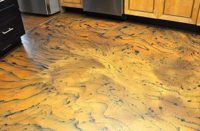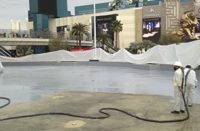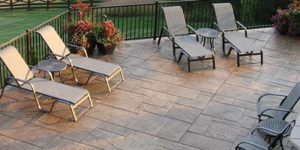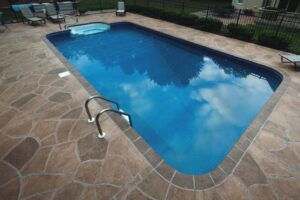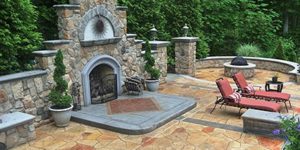
Decorative concrete contractors know how to turn plain concrete into works of art using various applications and techniques. What they may not know is how these applications and techniques affect the temperature of the concrete.
Concrete surfaces that have absorbed too much heat can have a dire effect on comfort, the environment, energy use and even health and safety. When outdoor concrete surfaces absorb UV rays from the sun, they consequently release them into the atmosphere, often resulting in what’s known as the urban heat island (UHI) effect. The UHI effect causes heat to travel into nearby structures, air and water, leading to human discomfort, overheated storm-water runoff, an increased need for energy to cool down buildings, and an increased risk of health problems for people living in the area, such as respiratory complications, experts say.
If the concrete surface is a pool deck, backyard patio or theme park, it’s a no-brainer that heat will cause discomfort for anyone who walks around barefoot.
“There are three primary areas of concern when it comes to concrete temperature,” says Chris Sullivan, vice president of sales and marketing for manufacturer ChemSystems Inc. “The first is when skin is going to make direct contact with a surface. The second is energy — more energy is required to cool down large commercial spaces that are affected by hot surfaces. And the third is safety. In parking lots and on biking trails, lighter, cooler concrete will be much more lit up and bright at night.”
Yes, concrete temperature is even related to safety, although in a roundabout way. It’s a general rule that the lighter the color of concrete, the less heat it absorbs. If light-colored concrete is used in areas that require lighting at night (such as parking lots and bicycle paths) the light color will boast a cooler surface and allow the area to be lit more efficiently. strong
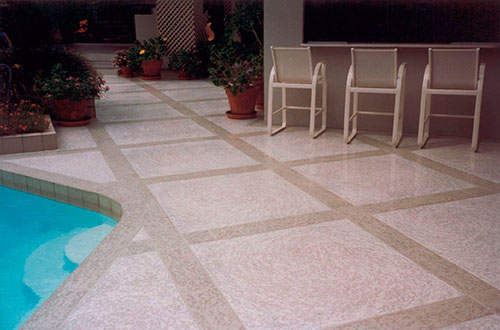
What is SRI?
Surface coolness is often determined by the surface’s solar reflectance index (SRI) value, a measurement of how much solar energy is reflected and emitted by a surface. SRI values range from zero to 100, with surfaces valued at zero absorbing the highest amount of solar energy and surfaces valued at 100 absorbing the lowest amount of solar energy.
On its own, uncolored concrete typically measures above 29 SRI, which is good news if a building owner is after Leadership in Energy and Environmental Design (LEED) points. In order to meet the LEED requirement for environmentally friendly surface temperature, the surface’s SRI must be 29 or greater, and with concrete, it’s much easier to meet this requirement than with, say, asphalt. Due to their extreme porosity, asphalt surfaces can never be classified as cool.
“Even if you color asphalt white, it still won’t pass the SRI value of 29,” Sullivan says. “It’s such a porous product that heat will bounce around and heat up the inside. Concrete is much denser, so heat energy is not readily absorbed.”
Scoring LEED points
Cooler concrete can help earn LEED points for new construction projects in several ways. An SRI rating of 29 or greater for an outdoor concrete surface can score owners and developers one LEED point, and the energy optimization and reduced light pollution made possible by cooler concrete can also help earn points, says Frank Klemaske, executive vice president for San Diego-based decorative concrete contractor T.B. Penick & Sons Inc.
Since green construction is all the rage, knowing how concrete temperature affects LEED ratings can be of value to decorative concrete contractors, experts say.
“Understanding how concrete contributes to sustainable practices is one of the most important issues in the industry,” says Clark Branum, UltraFlor program manager for Diamatic USA. “But you’re not going to be selling a job just because of SRI values. It’s going to be a combination of things.”
Commercial clients who are after energy efficiency and/or LEED points will care the most about controlling heat in concrete surfaces, experts say. Government-funded projects are usually on the forefront of concern. Some affluent homeowners are also showing interest in environmentally conscious features. “Federal and municipal projects, universities and some residential buildings are demanding green,” Klemaske says.
Some clients may not actively seek the inclusion of cool concrete surfaces in a project but would become interested once they know the benefits involved. Klemaske says building developers and owners who are after cost savings are likely to spring for cooler concrete once informed. Rich Cofoid, national sales manager for manufacturer Increte Systems, adds that environmentally conscious materials will soon be a priority for clients of all sizes.
“Tax advantages and PR notoriety come along with having LEED points,” Cofoid says. “Larger companies and developers will have more impact and are more likely to be interested, but it will eventually trickle down to all buildings, so it’s worth marketing to those clients.”
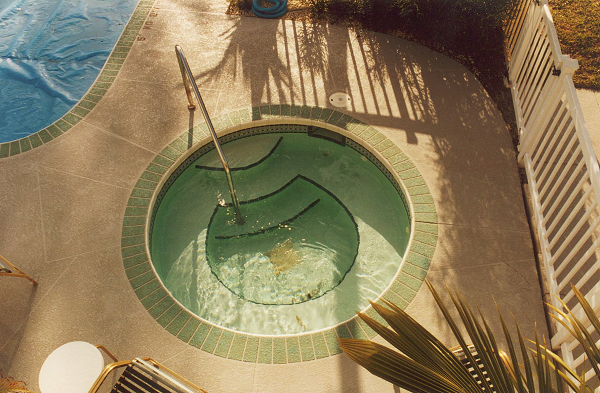
What affects heat in concrete
While concrete is a cool material on its own, certain decorative products, applications and techniques can help make surfaces even cooler. Temperatures of decorative concrete surfaces are affected by color, texture and the application of some coatings, experts say.
Lighter colors reflect more heat, making the surface cooler, and darker colors absorb more heat, making the surface hotter. Beiges and light grays will allow surfaces to meet or surpass the SRI requirement of 29, while dark browns and charcoals may not, Cofoid says. “The goal is to choose a color that has an SRI value that’s equal to or greater than that of plain concrete.”
Why would a contractor improve upon uncolored concrete — which meets LEED’s SRI requirements on its own — in order to cool it down further? Nick Paris of manufacturer Davis Colors says it depends on the surface’s location.
“Let’s say the SRI value of uncolored concrete is 40, and you want it to be 80,” Paris says. “Would someone pay to increase the surface’s reflectance? Perhaps yes, if the concrete is for a roof or exterior building surface. When white concrete is used in this way it will help reduce the heat inside the building and lower air conditioning costs. Most customers won’t pay extra to increase SRI above LEED requirements on paving applications.”
Texture can also result in cooler surfaces, experts say. This is because textured concrete allows for increased airflow and can create small shadows that are cool like the shade of a tree or awning. Also, heat bounces off irregular surfaces in greater amounts than it does off smooth ones. And if a barefoot person walks on an irregular surface, air pockets will prevent his or her feet from touching the surface completely. You can see why texture is a great choice for a pool deck.
“Glass-smooth surfaces will get 100 percent exposure to sunlight because there’s no place for the sun to not hit them,” Sullivan says. “If you start adding texture, the air will circulate and move differently.”
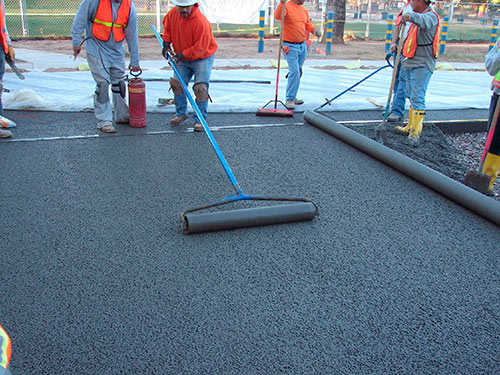
Pervious concrete — a well-known environmentally friendly choice due to its storm-water management capabilities — has its own properties when it comes to temperature control. Mike Riggs, manager for the Phoenix, Ariz.-based decorative concrete contractor Progressive Hardscapes and an installer of the Drainscape pervious concrete system, says that while pervious concrete carries a lower SRI value than regular concrete does, it cools off more quickly at night.
“The problem with pervious concrete is its texture — it’s like a Rice Krispies bar,” Riggs says. “So sunlight is not going to bounce off as much. But from a heat island effect standpoint, it’s going to cool off more quickly at night because it has less thermal mass than standard concrete.”
Other decorative concrete materials can affect temperature as well. Cofoid says incorporating mica products, which make concrete surfaces sparkle, can increase reflectivity, making the concrete cooler to the touch. Klemaske says embedded glass can also help, since it absorbs less heat than concrete does. Some manufacturers have developed special stains, toppings and integral colors designed to help reduce surface temperature.
Branum points out that proper maintenance can also help keep surfaces cool. Keeping concrete clean and sealed helps it achieve peak reflectivity. This helps make the surface cooler because when a surface reflects sunlight, the light bounces away before its heat has a chance to be absorbed into the surface.
Finally, choosing sealers and coatings that stand the test of time will keep surface temperatures low — when a topping wears off, surface pores can become clogged up, which lowers SRI value. “Most contractors are already sustainable providers,” Branum says. “They just may not know it.”
